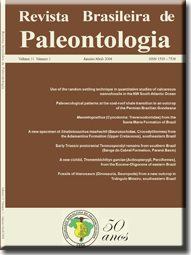PALEOECOLOGICAL PATTERNS AT THE COAL-ROOF SHALE TRANSITION IN AN OUTCROP OF THE PERMIAN BRAZILIAN GONDWANA
DOI:
https://doi.org/10.4072/rbp.2008.1.02Resumen
The paleoecology of the depositional interval at the transition from a peat-forming to a clastic environment in an outcrop of the Rio Bonito Formation (Sakmarian) of the southern Paraná Basin (Rio Grande do Sul State, Brazil) is outlined here. The autochtonous roof shale flora is dominated by a homogeneous assemblage of in situ arborescent lycopsid casts (Brasilodendron pedroanum), associated with understorey forms (Botrychiopsis valida, Lycopodites sp., rhodeopterid forms) and hypoauthochtonous conifers (Coricladus quiteriensis), as well as leaves of Rubidgea and Cordaites, transported from nearby lowland areas. Palynological observations in the underlying coal bed combined with studies of the roof shale indicate that the roof shale plant assemblage reflects partly the plants that grew in peat-forming swamps which originated the hypoauthochtonous coal. Quantitative and qualitative differences between peat-forming and clastic paleofloras are linked to changes in paleosoil characteristics. Episodic flooding by washover fans was the dominant controlling process in the evolution of facies in the vegetated coastal area, over a relatively short time scale. High levels of structured fusinite and inertodetrinite, shown by petrographic analysis in carbonaceous shales, as well as the presence of charcoal in the clastic entisoil, reflect frequent fires disturbing nearby lowland areas. Paleoecological characteristics of the megaflora indicate wet- dry oscillations during the depositional interval, which should be related to climatic seasonality. A framework is proposed for the development of peat and subsequent process of colonization, succession and burial of a clastic plant-community preserved as roof shale flora.
Descargas
Publicado
Cómo citar
Número
Sección
Licencia
This is an Open Access article distributed under the terms of the Creative Commons Attribution-NonCommercial-NoDerivatives license (http://creativecommons.org/licenses/by-nc-nd/4.0), which permits non-commercial re-use, distribution, and reproduction in any medium, provided that no alterations are made and the original article is properly cited. The written permission of Revista Brasileira de Paleontologia must be obtained before any commercial use and/or adaptation of the article.







